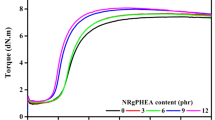Abstract
Vulcanisation is the key process for determining the final properties of elastomers due to the relationship between curing condition and viscoelastic behaviour. This study focuses on the variations in the dynamic behaviour of silica-filled natural rubber caused by crosslinking. The rubber samples with different degrees of curing (DOC) are prepared by thermal quenching during the crosslinking process. The strain sweep mode is used to study the Payne effect. The Kraus model is used to fit the test data. The relationship between the parameters of Kraus model and DOC is obtained at small strain (< 10%). The storage modulus at small strain amplitudes (usually < 0.01%) \( G^{\prime}_{ 0} \) is proportional to DOC; however, the storage modulus at large strain amplitudes \( G^{\prime}_{\infty } \) has small changes with DOC. The characteristic value of the strain amplitude \( \gamma_{\text{C}} \) shifts to large strain and the maximum loss modulus \( G^{\prime\prime}_{\text{m}} \) decreases with the increase of DOC. In addition, a deviation between Kraus model and experiment is observed when the strain is larger than 10%, and the loss modulus increases with the increase of strain amplitude. The deviation decreases when DOC increases. The mechanism for this deviation is discussed and the interaction between silica filler and rubber chain might be responsible for the observed deviation.



Similar content being viewed by others
References
Song CZ, Che YX, Zhang ZG, Du AH (2011) Effect of silane coupling agent on filler network structure and dynamic mechanical properties of carbon black/silica reinforced nitrile rubber, China. Synth Rubber Ind 34(2):128–132
Attard MM, Hunt GW (2004) Hyperelastic constitutive modeling under finite strain. Int J Solids Struct 41(18–19):5327–5350
Arruda EM, Boyce MC (1993) A three-dimensional constitutive model for the large stretch behavior of rubber elastic materials. J Mech Phys Solids 41(2):389–412
Drozdov AD, Dorfmann A (2003) Finite viscoelasticity of filled rubber: experiments and numerical simulation. Arch Appl Mech 72(9):651–672
Wu JD, Kenneth ML (2000) Multiaxial and time dependent behavior of a filled rubber. Mech Time Depend Mater 4(4):293–331
Song Y, Zeng L, Zheng Q (2017) Reconsideration of the rheology of silica filled natural rubber compounds. J Phys Chem B 121(23):5867–5875
Diani J, Fayolle B, Gilormini P (2009) A review on the Mullins effect. Eur Polym J 45(3):601–612
Fu W, Wang L (2016) Research on Payne effect of natural rubber reinforced by graft-modified silica. J Appl Polym Sci 133(36):43891–43898
Gan S, Wu ZL, Xu H, Song YH, Zheng Q (2016) Viscoelastic behaviors of carbon black gel extracted from highly filled natural rubber compounds: insights into the Payne effect. Macromolecules 49(4):1454–1463
Studebaker ML, Beatty JR (1972) The oxidative hardening of SBR. Rubber Chem Technol 45(2):450–466
Suetsugu Y, White JL (1983) The influence of particle size and surface coating of calcium carbonate on the rheological properties of its suspensions in molten polystyrene. J Appl Polym Sci 28(4):1481–1501
Wang YS, Su BL, Wu J (2012) Simulation and optimization of giant radial tire vulcanization process. Procedia Eng 31(18–19):723–726
Schaefer RJ (1995) Tech service: dynamic properties of rubber. Rubber World 211(4):16–19
Neogi C, Bhattacharya AK, Bhowmick AK (1989) Dynamic mechanical analysis of carbon black filled rubber compounds under swollen conditions. Rubber Chem Technol 62:651–659
Ruddock N, James PW, Jones TER (1993) Modelling the linear viscoelasticity of unfilled and carbon black loaded elastomers. Rheol Acta 32(3):286–292
Funt JM (1988) Dynamic testing and reinforcement of rubber. Rubber Chem Technol 61(5):842–865
Chambon F, Winter HH (1985) Stopping of crosslinking reaction in a PDMS polymer at the gel point. Polym Bull 13(6):499–503
Kraus GJ (1984) Mechanical losses in carbon-black-filled rubbers. Appl Polym Symp 39(1):75–92
Hu XL, Luo WB, Liu X, Huang YJ, Bu JL (2013) Temperature and frequency dependent rheological behavior of carbon black filled natural rubber. Plast Rubber Compos 42(10):416–420
Kim BK, Youn SK (2001) A viscoelastic constitutive model of rubber under small oscillatory load superimposed on large static deformation. Arch Appl Mech 71(11):748–763
Cho JH, Youn SK (2006) A viscoelastic constitutive model of rubber under small oscillatory load superimposed on large static deformation considering the Payne effect. Arch Appl Mech 75(4–5):275–288
Lion A, Kardelky C (2004) The Payne effect in finite viscoelasticity-constitutive modelling based on fractional derivatives and intrinsic time scales. Int J Plast 20(7):1313–1345
Huber G, Vilgis TA, Heinrich G (1996) Universal properties in the dynamical deformation of filled rubbers. J Phys Condens Matter 8(29):409–412
Heinrich G, Klüppel M (2002) Recent advances in the theory of filler networking in elastomers. In: Lee K-S (ed) Advances in polymer science, vol 160. Filled elastomers drug delivery systems series. Springer, Berlin, pp 1–44
Acknowledgements
This work is funded by Major Program of National Natural Science Foundation of China (51790502), Shandong Provincial Natural Science Foundation Youth Program (ZR2018QEE004), and the joint construction project of HIT and Weihai (2017DXGJ01, 2017DXGJ11).
Author information
Authors and Affiliations
Corresponding author
Ethics declarations
Conflict of interest
The authors declare that they have no conflict of interest.
Additional information
Publisher's Note
Springer Nature remains neutral with regard to jurisdictional claims in published maps and institutional affiliations.
Rights and permissions
About this article
Cite this article
Wu, J., Chen, L., Su, B.L. et al. Evolution of Payne effect of silica-filled natural rubber in curing process. J Rubber Res 22, 127–132 (2019). https://doi.org/10.1007/s42464-019-00018-7
Received:
Accepted:
Published:
Issue Date:
DOI: https://doi.org/10.1007/s42464-019-00018-7




